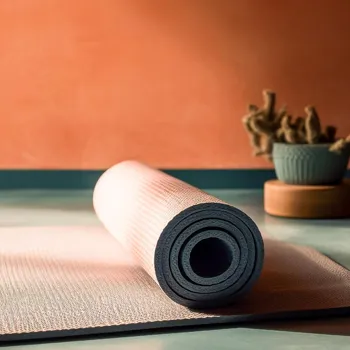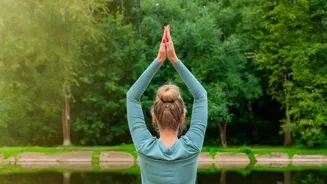Explore 7 Yoga Techniques to Cultivate Mindfulness in a Busy World. Find peace and calm amidst chaos
In today's fast-paced India, life can feel like a never-ending race. We're constantly bombarded with
deadlines, traffic jams, and the pressures of modern society. It's no wonder that so many of us feel stressed, anxious, and overwhelmed.
But there's a solution that has been practiced for centuries in our very own land: yoga. More specifically, incorporating mindfulness into your yoga practice can be a powerful tool for finding peace and calm amidst the chaos.
Mindfulness, at its core, is about paying attention to the present moment without judgment. It's about noticing your thoughts, feelings, and sensations without getting carried away by them. This simple act of presence can have a profound impact on your well-being.
Yoga, when combined with mindfulness, becomes more than just a physical exercise. It becomes a moving meditation, a way to connect with your body and mind in a deeper way.
By focusing on your breath, your body's sensations, and the present moment, you can quiet the mental chatter and find a sense of inner peace. Let's explore seven accessible yoga techniques that can help you cultivate mindfulness and find serenity in your busy Indian life.
These techniques are designed for everyone, regardless of their experience level. Remember, the goal is not to achieve perfect poses, but to cultivate awareness and acceptance. So, grab your yoga mat (or just a comfortable space on the floor), and let's begin!
Mindful Breathing (Pranayama): The Foundation of Calm
Pranayama, or breath control, is the cornerstone of any mindful yoga practice. It’s about consciously regulating your breath to calm your nervous system and bring you into the present moment. One of the simplest and most effective techniques is called Diaphragmatic Breathing, or belly breathing.
Sit comfortably, either on a chair or on the floor. Place one hand on your chest and the other on your belly. As you inhale, focus on expanding your belly, feeling your hand rise. Your chest should remain relatively still. As you exhale, gently contract your belly, feeling your hand lower.
Repeat this for 5-10 minutes, paying attention to the sensation of your breath entering and leaving your body. Another helpful technique is Alternate Nostril Breathing (Nadi Shodhana Pranayama). Use your right thumb to close your right nostril and inhale deeply through your left nostril.
Then, close your left nostril with your right ring finger and exhale through your right nostril. Inhale through your right nostril, then close it and exhale through your left nostril. Continue alternating, focusing on the flow of breath and the sensation of each inhale and exhale.
These breathing exercises are simple yet powerful tools to anchor you in the present moment, reducing stress and promoting relaxation. You can practice them anytime, anywhere, whether you're stuck in traffic, waiting in line, or feeling overwhelmed at work.
Sentence Count: 3
Gentle Stretching (Asanas) with Awareness:
Yoga asanas, or poses, are more than just physical exercises; they are opportunities to explore your body and mind. The key to making them mindful is to move slowly and deliberately, paying attention to every sensation. Start with simple poses like Mountain Pose (Tadasana).
Stand tall with your feet grounded, your spine straight, and your shoulders relaxed. Close your eyes and feel the connection between your feet and the earth. Notice the gentle rise and fall of your chest as you breathe. Feel the strength in your legs and the length in your spine.
Another great option is Child's Pose (Balasana). Kneel on the floor with your knees slightly apart. Fold forward, resting your forehead on the ground. Extend your arms forward or alongside your body. Relax your shoulders and back, and allow yourself to sink into the pose.
Focus on your breath and the gentle pressure of your belly against your thighs. As you move through these poses, notice any areas of tension in your body. Gently breathe into those areas, allowing them to soften and release. Avoid pushing yourself beyond your limits.
The goal is not to achieve a perfect pose, but to cultivate awareness and acceptance of your body in the present moment. Remember to listen to your body and modify the poses as needed.
Sentence Count: 3
Mindful Walking (Walking Meditation):
We often rush through our day, barely noticing the world around us. Mindful walking is a simple yet profound way to reconnect with your surroundings and ground yourself in the present moment. Choose a quiet place to walk, whether it's a park, a garden, or even your own terrace.
As you walk, pay attention to the sensation of your feet making contact with the ground. Notice the weight shifting from one foot to the other. Feel the muscles in your legs and feet working to propel you forward. Observe the sights, sounds, and smells around you.
Notice the colours of the flowers, the sound of the birds chirping, the scent of the earth after rain. Resist the urge to judge or analyze what you see, hear, or smell. Simply observe with curiosity and acceptance. If your mind wanders, gently guide it back to the sensation of walking.
You can also focus on your breath, counting each inhale and exhale. The goal is to stay present and engaged with the experience of walking. Mindful walking can be a wonderful way to start or end your day, providing a sense of calm and clarity amidst the chaos of urban life.
Even a short 10-minute walk can make a big difference in your overall well-being.
Sentence Count: 3
Body Scan Meditation: Cultivating Body Awareness
The body scan is a powerful technique for cultivating body awareness and noticing areas of tension or discomfort. Lie down comfortably on your back with your arms at your sides and your palms facing up. Close your eyes and take a few deep breaths. Bring your attention to your toes on your left foot.
Notice any sensations, whether it's warmth, coolness, tingling, or pressure. Simply observe without judgment. Slowly move your attention up your left foot, feeling your heel, your ankle, and your calf. Continue scanning your entire body, from your toes to the top of your head.
Pay attention to any areas of tension or pain. Imagine breathing into those areas, allowing them to soften and release. If your mind wanders, gently guide it back to your body. The goal is not to fix anything, but simply to observe and accept your body as it is in this moment.
The body scan can be particularly helpful for identifying and releasing chronic tension. It can also help you develop a greater sense of connection with your body, promoting relaxation and well-being.
Practice this meditation for 15-20 minutes, allowing yourself to fully relax and sink into the present moment.
Sentence Count: 3
Loving-Kindness Meditation (Metta): Spreading Positivity
Loving-kindness meditation, or Metta, is a practice of cultivating feelings of love, compassion, and kindness towards yourself and others. Find a comfortable position and close your eyes. Take a few deep breaths and bring to mind someone you care about deeply.

Silently repeat the following phrases: "May you be well. May you be happy. May you be peaceful. May you be free from suffering." Feel the warmth and love radiating from your heart towards this person. Next, bring to mind yourself. Repeat the same phrases: "May I be well. May I be happy.
May I be peaceful. May I be free from suffering." Allow yourself to receive these feelings of love and compassion. Then, bring to mind someone you feel neutral towards, perhaps a neighbour or a colleague. Repeat the phrases, extending your kindness to them.
Finally, bring to mind someone you find difficult or challenging. Repeat the phrases, sending them your love and compassion. This may be difficult at first, but remember that everyone deserves kindness and understanding.
Practice this meditation for 10-15 minutes, expanding your circle of loving-kindness to include all beings. Metta meditation can help you develop greater empathy, compassion, and resilience.
Sentence Count: 3
Yoga Nidra (Yogic Sleep): Deep Relaxation
Yoga Nidra, often called "yogic sleep," is a guided meditation that induces a state of deep relaxation. It's practiced lying down in Shavasana (corpse pose), and involves systematically relaxing each part of the body while staying consciously aware.

Find a quiet and comfortable space where you won't be disturbed. Lie down on your back with your arms at your sides and your palms facing up. Close your eyes and take a few deep breaths. Follow the instructions of a guided Yoga Nidra recording.
The guide will lead you through a body scan, visualization exercises, and affirmations. As you listen to the guide, allow yourself to relax more and more deeply. The goal is not to fall asleep, but to remain aware while your body and mind are in a state of deep relaxation.
Yoga Nidra can help reduce stress, improve sleep, and enhance overall well-being. It's a fantastic way to recharge and rejuvenate your mind and body after a long day. Practice Yoga Nidra for 20-30 minutes, allowing yourself to fully surrender to the experience.
Sentence Count: 3











